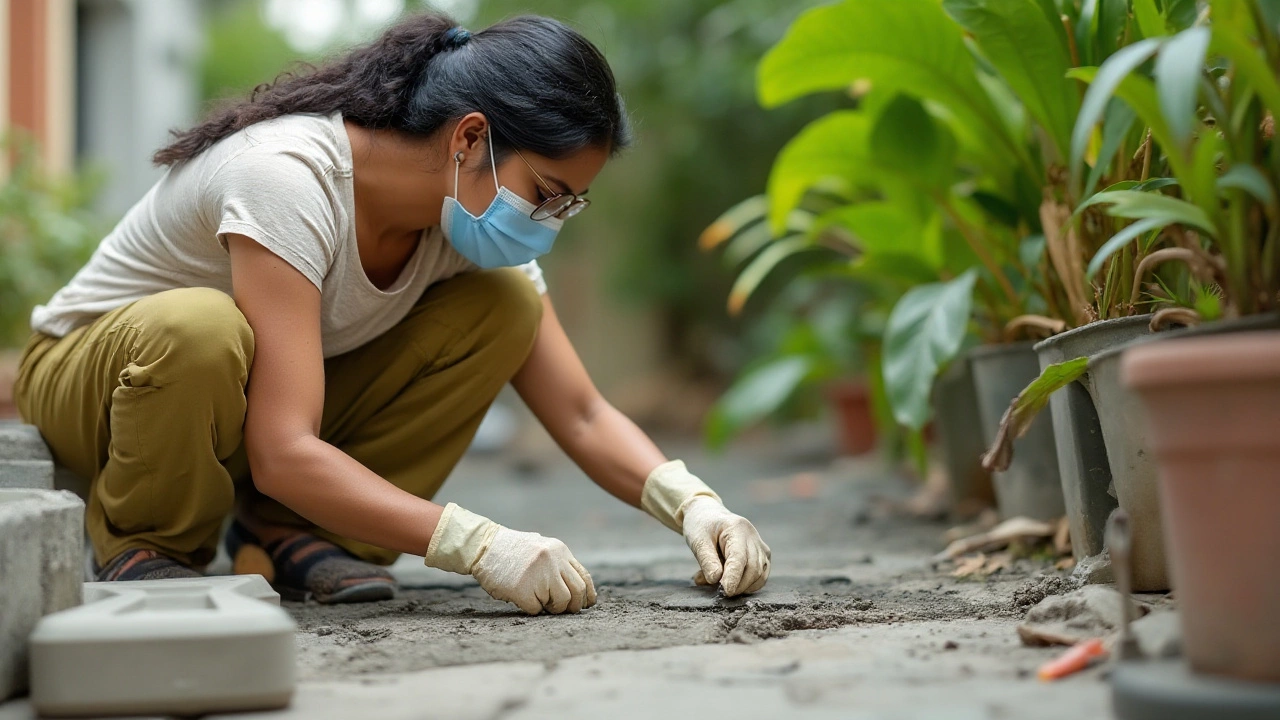DIY Foundation Repair: Fix Your Home's Foundation Like a Pro

Fixing your home’s foundation might seem like a daunting task, but with the right knowledge, many issues can be managed by homeowners themselves. It's crucial to address foundation concerns promptly, as neglect can lead to more severe damage over time.
Before diving into the repair process, it's important to understand the signs of foundation problems. You might notice small cracks in walls, doors that don't close properly, or uneven floors. These are often indicators that something beneath the surface needs attention.
This guide will walk you through the necessary steps to tackle minor foundation repair tasks, providing you with the confidence to maintain your home's integrity and safeguard its value. Whether you're dealing with hairline cracks or small shifts in the structure, there are solutions at hand that won't require a loan or back-breaking labor.
- Identifying the Problem
- Essential Tools and Materials
- Step-by-Step Repair Process
- Long-term Maintenance Tips
Identifying the Problem
Identifying foundation problems early is crucial in preventing larger structural issues that could compromise your home’s integrity. The first step in addressing potential problems is to know what to look out for. Start by observing the most common symptoms which can manifest both inside and outside the house. Inside your home, you may find cracks in walls that extend diagonally, horizontally, or in a stair-step pattern. These are often signs of stress within the walls and indicate movement or shifting in the foundation. Similarly, sticking doors and windows, or those that no longer align correctly, are telltale signs of a foundation in distress. You might also notice gaps where walls and floors meet, which can often creep up over time, making them easy to overlook.
On the exterior, keep an eye out for cracks in the foundation itself or in the brickwork. Cracks wider than a quarter inch are cause for concern and warrant further investigation. Also, if your home appears to be sinking or pulling away from itself on any sides, it might point towards underlying foundation woes. Sometimes, rotating or leaning chimneys can also signal foundation instability as they reflect the underlying structure's ability to support lateral loads. In addition, always be vigilant about water pooling around the base of your home, as excess moisture is often a precursor to significant damage.
"Just like with human health, preventative home care is always less costly than a cure." - Property Maintenance Journal
Another practical approach is to perform a simple leveling test. Place a ball on a floor that you suspect might not be level and watch how it moves. If the ball rolls rapidly across the floor, this could suggest foundation movement causing uneven surfaces. Foundation cracks and movements can also be common in older homes, which have settled over decades, but prudent vigilance is crucial. Sharing these insights is vital, as is understanding local soil conditions, which play a pivotal role. In areas with expansive clay soils, for instance, foundations are more prone to shifting with moisture changes.
Important Statistics to Consider
According to a survey by the American Society of Civil Engineers, approximately 25% of homes in the US encounter structural issues that involve foundation failure. Knowing the statistics of your own home’s region can be beneficial; this includes understanding local water tables and extensive research into historical patterns of settlement and movement in the area. The National Association of Home Builders suggests that such foundational imbalances can seriously impact property value if left unaddressed.
With these insights, you can better identify the early warning signs of foundation issues. Knowing what to look for gives you a head start on resolving minor issues before they escalate into significant problems, allowing for effective home improvement strategies. Remember, taking the time to frequently inspect your base structure is not only about fixing what's broken but preventing what's costly to repair.

Essential Tools and Materials
Tackling DIY foundation repair requires a solid collection of tools and materials that will make the job efficient and effective. Before beginning the repair process, stock up on these essentials, keeping in mind the need for durability and quality to ensure lasting results. A crucial first step is a visual inspection, but once you find the problem areas, you'll need more than a keen eye.
First off, ensure you have a good level—preferably a laser level for accuracy that can help assess the true state of your home’s walls and floors. Any deviation could indicate areas needing attention. Next, a crack monitor will come in handy. This device helps to track whether foundation cracks are growing over time, which is vital to determine the right repair method.
For the actual repair of small cracks, the game-changer is a concrete patch repair kit. These kits often include a pre-mixed compound that can fill in and seal cracks. For wider or deeper cracks, use a hydraulic cement mix. This material expands as it cures, locking into the crevices and forming a reliable seal. You’ll also need a trowel—this tool is essential for applying patches or cement smoothly.
A chisel and hammer are fundamental for any repair that involves removing damaged or loose concrete. They help create clean edges, allowing for proper bonding of new materials. Make sure to have safety gear, too. Goggles, gloves, and a dust mask protect against debris and dust during demolition or mixing tasks. A foundation repair isn’t just about tools; safety should be your utmost priority.
Beyond the basic tools, a reliable moisture meter is invaluable. This device measures moisture levels in concrete and soil, critical in determining the root causes of foundation issues. High moisture levels can lead to soil expansion, affecting your foundation. Keeping these metrics in check ensures proactive maintenance.
Some experts also recommend using a specialized foundation repair epoxy. These are particularly useful for areas where traditional cement might fail due to continuous movement. As an alternative, polyurethane foam injections can fill voids and stabilize the ground effectively, often used where traditional materials might face limitations.
"Having the right tools not only makes DIY easier but also ensures long-lasting repairs," says John Ward, a foundation repair expert at HomeMechanix Magazine. "Investing in quality materials will save you time and money in the long run."
Here’s a handy list of essential tools:
- Laser Level
- Crack Monitor
- Concrete Patch Repair Kit
- Hydraulic Cement
- Trowel
- Chisel and Hammer
- Safety Gear (Goggles, Gloves, Dust Mask)
- Moisture Meter
- Foundation Repair Epoxy or Polyurethane Foam
Gather these tools and materials before beginning the task and keep them organized in a tool chest or storage bin. This planning ensures you won’t be caught off guard halfway through the repair project. Proper preparation goes a long way in ensuring successful DIY foundation repair, keeping your home stable and safe for years to come.

Step-by-Step Repair Process
Embarking on a DIY journey to repair your foundation begins with understanding that precision and patience are your best allies. Before any repair, assess the severity of the damage. For instance, cracks less than a quarter of an inch wide usually signal a minor issue, whereas larger ones suggest something more serious. It's equally important to check whether the damage is active, meaning it expands with time, or if it's stable. This distinction will dictate your approach.
The first step in the actual repair process is gathering the right materials and tools. A solid plan requires starting with a crack inspection. High-quality materials can make a significant difference, so you might want to invest in a hydraulic cement or epoxy sealant, designed specifically for concrete repairs. You’ll also need a chisel and a wire brush for cleaning the cracks, a trowel for applying the compound, and safety gear for protection.
"Small repairs can thwart major headaches later," warns Jeff Wilson, a veteran DIY expert featured on HGTV. His insight underscores the importance of handling tiny issues before they evolve into costly disasters.
Once prepared, you can follow a straightforward path to achieve repairs akin to those completed by seasoned professionals. Start by thoroughly cleaning the cracked area with a wire brush to remove debris, dust, or loose concrete. This prepares the crack for better adhesion. Mix your repair compound as per the manufacturer's instructions, ensuring it's the right consistency to fill the voids seamlessly. Then, use a chisel to undercut the crack edges to create a key for the material.
Carefully fill the crack with your repair material, pressing it deep into the voids so it's firmly seated. Smooth out the surface with a trowel to level it with the existing concrete, ensuring there are no air pockets which can compromise the repair's integrity. Allow the compound ample time to cure. This curing process is critical for long-lasting repairs, and sometimes it is beneficial to set a protective barrier to control moisture levels and regulate temperature during hardening.
Finally, the repaired area should be monitored over time. Reassess the area every few months to check for new cracks or shifts. This gives you a glimpse into the effectiveness of your repairs and whether more extensive work might be required. Regular maintenance and swift action on new issues can dramatically extend the life of your DIY repairs, confirming the resilience of your efforts.

Long-term Maintenance Tips
Proper maintenance after a DIY foundation repair is crucial to ensure the longevity of your repairs and to prevent future issues. One key aspect is to manage the moisture levels around your home. This means avoiding excessive watering near the foundation, especially in areas prone to heavy rainfall. You should regularly check your gutters and downspouts to make sure they're directing water away from the foundation. Water pooling near the base of your home can erode the soil and stress the foundation, leading to issues that could have been prevented with routine maintenance.
Another important aspect of maintaining your home foundation is the landscape around your property. If you have trees and large shrubs near your walls, it's wise to monitor their growth, since their roots can interfere with the foundation. Make sure to plant any new trees at a safe distance from your home to avoid costly repairs. Regular pruning can also help manage the existing plant roots' growth, ensuring they do not extend too far toward your foundation.
Regular inspection is a good practice for maintaining your home's stability. Walk around your home every few months to look for signs of foundation distress, such as new cracks or changes in existing ones. Document your observations with photos or notes to keep track of any gradual changes. If you spot any new issues, act quickly; the sooner you address potential problems, the less likely they are to require expensive professional intervention.
An often overlooked aspect of long-term maintenance is controlling the temperature and humidity levels inside your home. Extreme fluctuations can cause materials within the structure to expand and contract, which may lead to minor or significant foundation shifts over time. Installing a whole-home humidifier or dehumidifier can help stabilize the interior climate, reducing the risk of temperature-induced structural issues on your valuable property.
As once noted by Bob Vila, a respected home improvement expert, "Routine maintenance and inspections are the key to extending your home's lifespan while preserving its structural beauty and integrity." Taking this advice to heart can save homeowners both time and expense in the long haul.
Lastly, having the right insurance in place can offer peace of mind. Make sure your homeowner’s insurance policy covers foundation problems, which can vary based on your location and the age of your home. Talk to your insurer to verify what is included, and consider adding additional coverage if necessary. While policies typically don’t cover neglect or standard wear and tear, they may help with damages from natural disasters or unforeseen accidents, which provides an added layer of protection.

